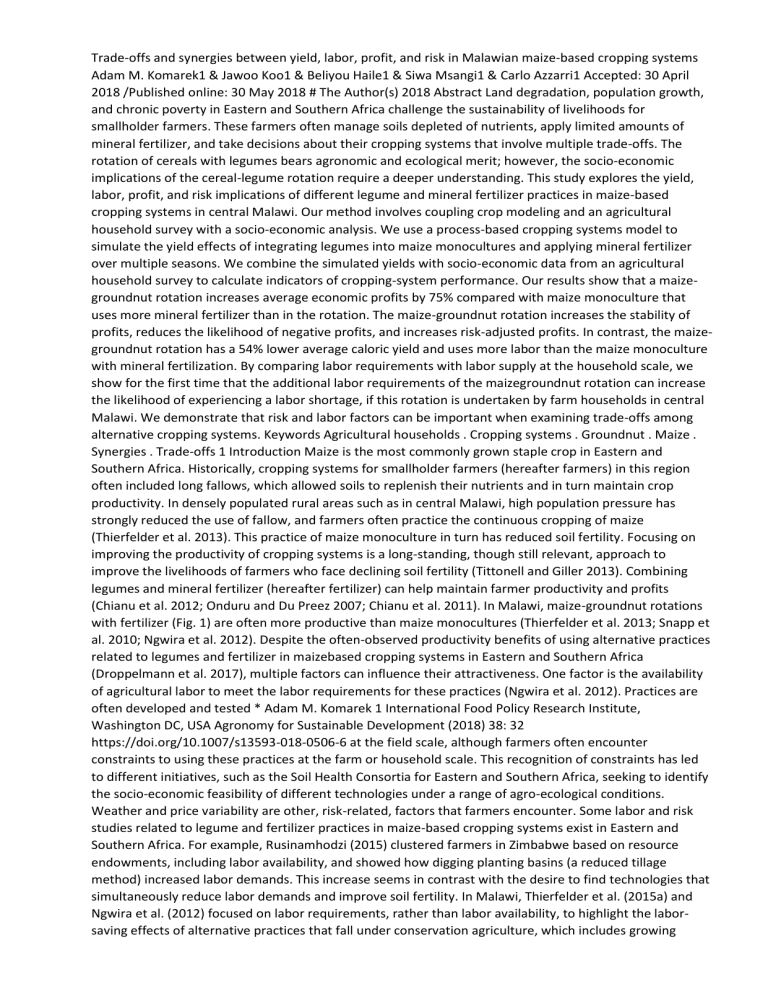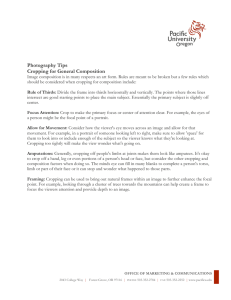
Trade-offs and synergies between yield, labor, profit, and risk in Malawian maize-based cropping systems Adam M. Komarek1 & Jawoo Koo1 & Beliyou Haile1 & Siwa Msangi1 & Carlo Azzarri1 Accepted: 30 April 2018 /Published online: 30 May 2018 # The Author(s) 2018 Abstract Land degradation, population growth, and chronic poverty in Eastern and Southern Africa challenge the sustainability of livelihoods for smallholder farmers. These farmers often manage soils depleted of nutrients, apply limited amounts of mineral fertilizer, and take decisions about their cropping systems that involve multiple trade-offs. The rotation of cereals with legumes bears agronomic and ecological merit; however, the socio-economic implications of the cereal-legume rotation require a deeper understanding. This study explores the yield, labor, profit, and risk implications of different legume and mineral fertilizer practices in maize-based cropping systems in central Malawi. Our method involves coupling crop modeling and an agricultural household survey with a socio-economic analysis. We use a process-based cropping systems model to simulate the yield effects of integrating legumes into maize monocultures and applying mineral fertilizer over multiple seasons. We combine the simulated yields with socio-economic data from an agricultural household survey to calculate indicators of cropping-system performance. Our results show that a maizegroundnut rotation increases average economic profits by 75% compared with maize monoculture that uses more mineral fertilizer than in the rotation. The maize-groundnut rotation increases the stability of profits, reduces the likelihood of negative profits, and increases risk-adjusted profits. In contrast, the maizegroundnut rotation has a 54% lower average caloric yield and uses more labor than the maize monoculture with mineral fertilization. By comparing labor requirements with labor supply at the household scale, we show for the first time that the additional labor requirements of the maizegroundnut rotation can increase the likelihood of experiencing a labor shortage, if this rotation is undertaken by farm households in central Malawi. We demonstrate that risk and labor factors can be important when examining trade-offs among alternative cropping systems. Keywords Agricultural households . Cropping systems . Groundnut . Maize . Synergies . Trade-offs 1 Introduction Maize is the most commonly grown staple crop in Eastern and Southern Africa. Historically, cropping systems for smallholder farmers (hereafter farmers) in this region often included long fallows, which allowed soils to replenish their nutrients and in turn maintain crop productivity. In densely populated rural areas such as in central Malawi, high population pressure has strongly reduced the use of fallow, and farmers often practice the continuous cropping of maize (Thierfelder et al. 2013). This practice of maize monoculture in turn has reduced soil fertility. Focusing on improving the productivity of cropping systems is a long-standing, though still relevant, approach to improve the livelihoods of farmers who face declining soil fertility (Tittonell and Giller 2013). Combining legumes and mineral fertilizer (hereafter fertilizer) can help maintain farmer productivity and profits (Chianu et al. 2012; Onduru and Du Preez 2007; Chianu et al. 2011). In Malawi, maize-groundnut rotations with fertilizer (Fig. 1) are often more productive than maize monocultures (Thierfelder et al. 2013; Snapp et al. 2010; Ngwira et al. 2012). Despite the often-observed productivity benefits of using alternative practices related to legumes and fertilizer in maizebased cropping systems in Eastern and Southern Africa (Droppelmann et al. 2017), multiple factors can influence their attractiveness. One factor is the availability of agricultural labor to meet the labor requirements for these practices (Ngwira et al. 2012). Practices are often developed and tested * Adam M. Komarek 1 International Food Policy Research Institute, Washington DC, USA Agronomy for Sustainable Development (2018) 38: 32 https://doi.org/10.1007/s13593-018-0506-6 at the field scale, although farmers often encounter constraints to using these practices at the farm or household scale. This recognition of constraints has led to different initiatives, such as the Soil Health Consortia for Eastern and Southern Africa, seeking to identify the socio-economic feasibility of different technologies under a range of agro-ecological conditions. Weather and price variability are other, risk-related, factors that farmers encounter. Some labor and risk studies related to legume and fertilizer practices in maize-based cropping systems exist in Eastern and Southern Africa. For example, Rusinamhodzi (2015) clustered farmers in Zimbabwe based on resource endowments, including labor availability, and showed how digging planting basins (a reduced tillage method) increased labor demands. This increase seems in contrast with the desire to find technologies that simultaneously reduce labor demands and improve soil fertility. In Malawi, Thierfelder et al. (2015a) and Ngwira et al. (2012) focused on labor requirements, rather than labor availability, to highlight the laborsaving effects of alternative practices that fall under conservation agriculture, which includes growing legumes, such as cowpea or pigeon pea, in rotation with maize. Ortega et al. (2016) used choice experiments in central Malawi to show that labor demands are a major constraint to legume adoption. Studies have also shown that maize can have a greater labor-use efficiency than legumes such as groundnut (Franke et al. 2014), and that conservation agriculture can also raise labor-use efficiency compared with conventional agriculture (Thierfelder et al. 2015b). However, simultaneously examining labor supply and demand for different cropping systems can help highlight possible trade-offs associated with maize-legume integration at the household scale. For risk, studies considering weather variability in Malawi have shown that systems with legumes can increase yield stability (Ngwira et al. 2012, 2014). Some of these studies have shown how maize-legume rotations can affect profits. For example, Ngwira et al. (2012) and Ngwira et al. (2014) used average grain prices to compare profits in conventional and conservation agriculture systems. A crosssectional study in Malawi showed that diversification of maize monoculture into a maizelegume system and using reduced tillage can increase crop yields and reduce downside risks (Kassie et al. 2015). Integrating legumes into maize monocultures and using fertilizer can increase productivity and partial profitability (Ngwira et al. 2012; Snapp et al. 2010). Ortega et al. (2016) urged additional research on risk and labor in the context of maize-legume systems. Based on the above-mentioned studies, we see scope to improve our understanding of the economic, risk, and labor effects of planting legumes and applying fertilizer in maize-based cropping systems. Our study aims to provide useful insights into the potential labor, economic, and risk effects of changes in cropping practices for farmers in central Malawi. Many of these previous studies use a partial economic budgeting approach, which often only considers the gross value of production and associated financial costs. We complement the existing literature by considering the opportunity cost of labor in our economic profit calculations. We supplement studies that use cross-sectional household survey data by including a risk analysis based on variability in both grain yields and prices over time, thus adding a temporal dimension to trade-off analysis. We complement the above-mentioned studies on labor-use efficiency by examining labor balances. Our study aims to answer two questions: 1. How do different legume and mineral fertilizer practices affect productivity, labor use, profit, and risk? 2. Do farmers access enough agricultural labor to sustain a maize-groundnut rotation?

